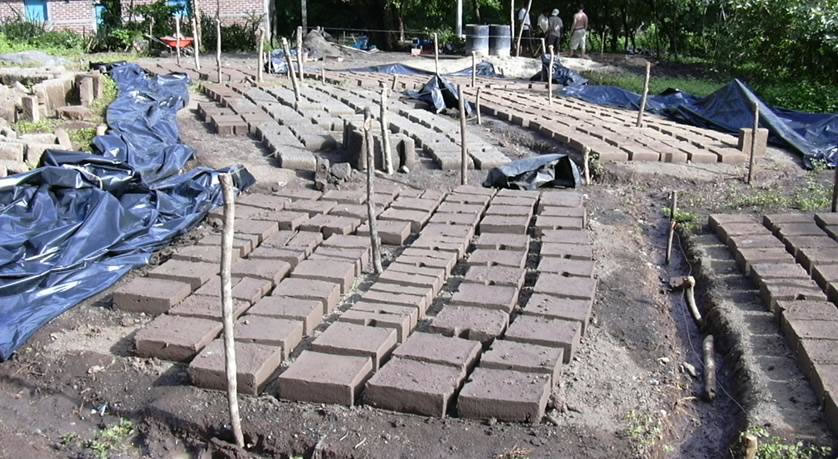

Difficulties and Problems
Excavation
The site donated to the project was near the centre of the community,
with an impressive view of the surrounding countryside. However, as noted
earlier it was dominated by a very large tree, so the preparation and
excavation of the site was a much greater task than had been anticipated.
Technically speaking this was not a problem, but the time taken put us
severely behind our schedule.
All of the blocks for the
building had to be made by hand and then dried out (a two week process).
This (as can be seen from the images) was another mammoth task. During
this time, the blocks had to be protected from rain and (initially) sun.
A particularly violent storm at the start of the rain season tore some
of the covers off the blocks, and almost two days work was wasted. Wastage
was also a problem, with at least 10% of the bricks unusable due to cracking
and breakages. Again, this put pressure on an already tight timescale.

Vertical Reinforcement
In order to connect the vertical reinforcement in the walls to the foundations, a series of L-shaped rebars were tied to the reinforcement in the bottom foundation. The bamboo reinforcement was then tied to the bars, which protruded through the second foundation. However, the spacing between the bamboo was crucial due to the design of the brick layers and their sizes, and in many places the spacing was disrupted through the process of placing the rebars and casting the foundation. The problem was solved in practice by adding spacing at the tie-in point for the bamboo, and varying the size of the mortar joint. However, a more reliable method for attaching the bamboo reinforcement would be of benefit to the construction process.
Shuttering
Laying the secondary foundations required the construction of shuttering. This was a complicated process due to the buttresses at each end and at midspan of each wall. The available plywood was also too thin, resulting in some bulging of the foundations. This is an aesthetic problem, and does not affect the structural properties of the building. However, the resulting complications to the shuttering process again caused delays in construction.
Water
Water was only available from a tap in the village, in the area used for blockmaking. Water had to be transported to site in large volumes especially for the pouring of concrete. Again, this was not technically difficult, but once again emphasised the importance of transport and logistics considerations on site.